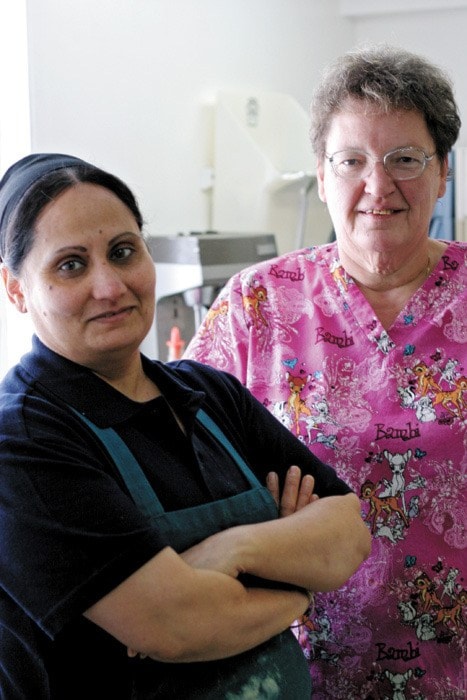Manjit Bhatti has put Houston on the culinary map.
Four times a year, the servers at Pleasant Valley Restaurant swap regular clothes for bright saris and serve Bhatti's Indian cuisine.
Owner Bev Lyons said that since it started five years ago, the Indian buffets have grown almost more popular than her kitchen can handle.
"It went over so well," said Lyons, adding that they get lots of people from out of town, especially Smithers and Telkwa.
"Everybody wanted us to do it a few times a year," she said. "Now they want us to do it every month—but it's just too much work."
Cooking the traditional dishes takes a lot of time.
"The ovens are on two or three days before," Bhatti said. Cooks Bobby Parmar and Charanjeet Dadwan join her in getting ready.
Touring the Pleasant Valley kitchen a few hours before dinner, it was easy to see why.
From one oven, Bhatti had just taken out a dish of steaming sabji—oven-roasted vegetables with curry spices and Bay leaves.
Bhatti opened another oven to show an eggplant bhurta—a northern Indian dish in which the eggplants are baked, peeled, mashed and baked again with spices.
Butter chicken, spinach sabji, a paneer dish—all the Pleasant Valley ovens were full, even as customers were ordering late-morning breakfasts off the stoves.
After swirling a heavy pot of dahl (a stewed lentil dish that is Lyons' favourite), Bhatti moved out of the main kitchen to the fridge where dessert was hiding.
"These are a lot of work and very expensive to make," she said, carefully taking down a plate of coconut-sprinkled gulab jamun.
Anyone who hasn't tried gulab jamun could be forgiven for mistaking it as a bigger-than-usual Timbit.
But take a bite, and it's an unmistakably richer treat. The hand-rolled balls of powdered-milk dough are fried and served in honey, rosewater or saffron syrup.
Bhatti's friend made 150 for the two-night dinner.
Expecting more guests, Bhatti also made a spiced rice pudding.
"We've never done that before, but a lot of people have been asking," she said with a smile.
Having cooked at Pleasant Valley for twenty years, Bhatti clearly knows her way around the kitchen.
Still, she said cooking wasn't something she grew up with.
"When I got married, I didn't know anything," she said, laughing. "Not at all."
Slowly, Bhatti picked up cooking tips from her sister and from elder Indian women in Houston.
Her learning curve really jumped after she joined in making meals for a Sikh summer camp. For days to a week, she helped prepare breakfast, lunch and dinner for 200 people.
"We had Indian and western food, and we switched them so no one would get bored," she said.
Today, Bhatti's cooking sense is finely tuned.
"I don't have to go through the recipes anymore," she said, adding that she can quickly size up a list of ingredients and prepare a dish her own way.
Bhatti said she is happy to share recipes. One of the simplest is for spiced chai (the Hindi word for "tea").
"It's really good in winter," Bhatti said of the hot beverage, adding that she and her children take chai with ginger.
"It keeps colds away," she said.
Here are Bhatti's tips for making a round of chai at home:
Pour 5 1/2 cups water into a pot. As you bring the water to a boil, add just over a teaspoon of fennel seeds and a few seeds of green cardamom (make sure they are out of their pods). Add four or five teaspoons of sugar and grated ginger.
Once the water is boiling, add four or five bags of orange pekoe tea (Bhatti says the Tetley brand works best). Boil the tea for a minute or so, longer if you like it strong. Add a teacup of milk and bring it almost to a boil before straining and serving the chai.
